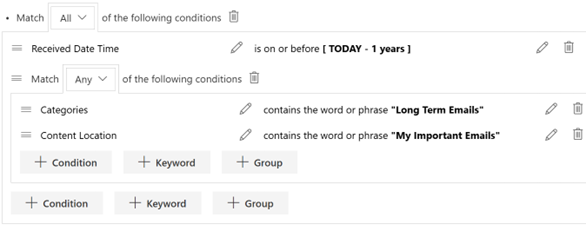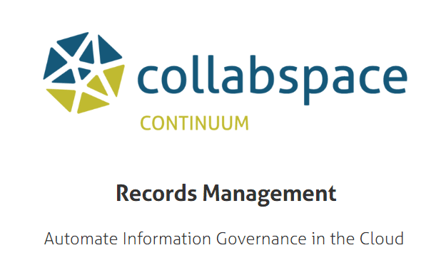Today marks a major milestone for the Collabware product development team. After two years of development, the next generation of Collabware CLM is now available for public preview and hands-on use. Collabware CLM 2016 represents the re-imagination of what it means to provide intelligent enterprise information governance for the Microsoft SharePoint platform. With new integrated case management, workflow, review, search, and reporting capabilities, Collabware CLM expands on its existing electronic and physical records management features to become an all-encompassing information governance solution.
Our goal with this release is to help you drive information worker productivity to new heights, automate information-based business processes, and have peace of mind knowing that your regulatory and legal compliance requirements are being met.
Exciting New Capabilities
True enterprise information governance means managing the complete lifecycle of all information and supporting the business processes that create and utilize that information. To achieve this we’ve introduced some very exciting new capabilities.
Aggregates for Case Management
Aggregates represent a logical grouping of distributed information (usually related to a person, place, or thing) that often is managed as a single unit. With this new capability you can define the Aggregates you utilize in your organization, and then expose them for end user creation and use as part of their case management business processes.
Aggregates also serve to increase productivity by making content much more findable. With the new Aggregate system, a user searching for a person, place, or thing will be presented with a search result that represents that Aggregate. Drilling into that search result allows the user to search and navigate only items associated to the Aggregate.
Here are some of the other amazing features that Aggregates offer:
- Can be represented by a SharePoint Site, although,
- Do not have to be represented by a SharePoint Site, and they can exist only as a concept that collects together many documents for any reason;
- Collect together SharePoint documents and Collabware CLM items, regardless of their location; this includes within Aggregate Sites, other locations, across different SharePoint Farms and in the future, O365 locations;
- Fully searchable items, appearing in the most basic keyword searches to far more granular searches using Collabware CLM’s new Search tools
- Documents and items collected in an Aggregate can be viewed together, searched, and refined;
- Can be classified as Records and used as a method of retaining and disposing of related material in bulk;
- Documents collected together within Aggregates can have their own classification, be captured as records, and complete their own individual disposition separately from the Aggregate;
- Documents can be associated to more than one Aggregate for different purposes;
- Can share metadata with all of its associated items, making it an effective way of updating document metadata in bulk, across different file types and locations;
- Can be created to represent an event, an activity, a user group, a physical location, and anything else our users can come up with; we really want Aggregates to be used for everything
Lifecycle Workflow
In order to support the complex business processes and lifecycles of Aggregates a new Lifecycle Workflow system has been introduced. This new workflow capability has been designed to handle all aspects of lifecycle management while also supporting the triggering and management of complex event-driven activities within the lifecycle process.
With the Lifecycle Workflow system an IT/IG/RM analyst can quickly and easily create a visual lifecycle process flow and deploy it automatically throughout the SharePoint environment. The workflow can then be applied to existing or future content using automated content rules. End users interacting with content that has applied workflows can also view the workflow state and progress visually within SharePoint.
Content Review
The existing Collabware CLM Disposition Approval process has been opened up and enhanced for use in multiple review processes such as Vital Records Review, Discovery Processing, FOI Request Processing, and of course Disposition Processing. The new generic Content Review process can be deployed as part of a Lifecycle Workflow to be triggered on event, time period, or based on volume of content, and allows multiple parties to easily and efficiently participate in the review process.
Within a Content Review activity participants can search, sort, filter, group, comment, and perform action on the content up for review. The results of the review can be branched in unlimited directions as part of the Lifecycle Workflow process, and a Certificate of Review can be generated capturing the results of the entire process.
Advanced Search
While SharePoint Search is excellent for keyword based searching, it falls well short of being effective for precise, metadata-based searching. To address this, Collabware CLM 2016 now contains a new metadata-based search technology that allows users to easily and efficiently locate content using precise content queries. The results of the queries are then presented in a view that allows further sorting and filtering so that users can quickly find and action on the results they are looking for.
Content Reporting
Building on top of the new search technology introduced into the product, Collabware CLM 2016 has added enhanced Content Reporting capabilities aimed at enabling IT/IG/RM analysts to quickly and efficiently profile their content and its usage over time. The new capabilities include the ability to query on content by metadata properties as well as end-user activities, and present the results in easily consumable formats.
NOTE: The Content Reporting enhancements are currently not available as part of the Public Technology Preview Program. They will be released for public preview in an upcoming update.
Public Technology Preview Program
The Collabware CLM 2016 Public Technology Preview Program represents an opportunity for your organization to have a hands-on experience trying out the new product capabilities. As part of this program we are also looking for your feedback so that we can continue to improve and enhance the product leading up to its final release in January, 2016.
We hope that you will get involved and help us ensure that Collabware CLM 2016 is the most advanced enterprise information governance software available for the Microsoft SharePoint platform.
If you are interested in participating in the program, please send an email to preview@collabware.com outlining the capabilities you are interested in evaluating and someone will contact you shortly to determine eligibility.




